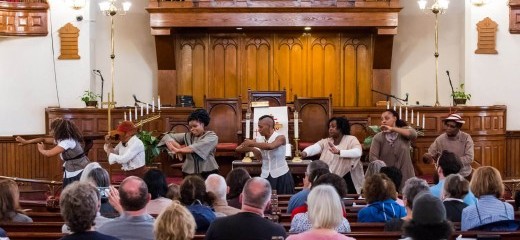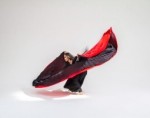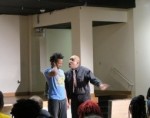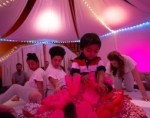
Side by Side: Philadelphia Churches (and bodies in them)
by Jenna Horton
In the graveyard of St Peter’s Church in Philadelphia, once a place of worship for many slaveholders, a new-green tenderness grows underfoot. The grounds communicate with pollinated glee: “I am fecund!” Some graves hold their dominating clear line against the new growth. Others have long since relinquished their edges to the mischief of springs past.
Bustling bodies gather (and sneeze) at the east entrance, shifting side to side, waiting for the processional portion of Grounds That Shout! (and others merely shaking), which includes performances by Meg Foley,
1. Foley hurls her voice across the graveyard. Her cry’s human scale bounces off the looming church steeple. St Peter’s is the only church we do not physically enter over the course of the procession. Why exactly, I can’t read—logistical? curatorial? organizational? artistic? Regardless, palpable. Vitche Boul Ra, mouth full of grass, cuts an arched diagonal across the length of the graveyard, leaving an energetic wake similar to a bird darting by. Still with me, the image of Foley dragging a limp Boul Ra for the length of a brick path….
This processional is merely one part of the multi-armed Grounds That Shout! programming. Presented by four partners (Partners for Sacred Places and Philadelphia Contemporary in partnership with Danspace Project (NYC) and the Center for Experimental Ethnography at the University of Pennsylvania), Grounds that Shout! continues Reggie Wilson’s research into sacred spaces, ecstatic movement, and African diasporic experience. The platform also offers Wilson’s choreography, they stood shaking while others began to shout, transposed from its first home at New York’s St Mark’s Church in-the-Bowery to Philadelphia’s Church of the Advocate (alongside the work of local artists Germaine Ingram and David Brick). Wilson also serves as “reluctant curator” of the procession, which traces through St Peter’s Church, Old Pine Street Church, and Mother Bethel AME Church. With Arielle Julia Brown serving as project dramaturge, the 50-page-long program appropriately communicates the density of such an undertaking, both audacious and daunting.
2. On a peal of bells, the
In his “Letter From the Curator,” Wilson makes clear his leading values from the get-go. Grounds That Shout! is “an experiment of multiple choreographers being in relationship to site, history, and people,” intended “initially for the choreographers but expanding to their collaborators, the congregations, and on some far end the viewers of the performed work.” As a viewer (and reviewer), I’m grateful for this gradient. It contains my judgment to its appropriately small and subjective scope.
3. Veiled, Jones, amidst a canopy of fish nets and red rope, resides in Old Pine. The most imagistic of the procession, she embodies the moving tableaus supply. The silence and solitude of her figure while laughing or preaching (her body gesticulating theatrically) has an eeriness to it. Midway, she extends a hand to Papa Ed Stokes, whose gait speaks of more days spent on this earth. The veil continues to speak also, drawing my attention to a constant boundary and perhaps protection….
Site, history, people—we’re in relationship to these elements, whether we attend to them or not. Their scale? Massive to microscopic, and never fully known—like a meal you can never fully digest. Isaac articulates it beautifully (among many other things) in sanctuary, “the story that I am is tethered to the histories of everything that has ever existed here. Before. And now.” Before. And now. Possible to grasp theoretically, another thing entirely when experienced in the body—producing, perhaps, a shake or a shout. Or making hairs stand on end in something like ecstasy.
4. Given the unwieldy scale of what it needs to stitch together, the procession plods in a kind of expected herky-jerky between ambulating and dropping into proscenium. Karen Dilossi, director of Arts in Sacred Places, serves as head/heir usher. Her tone throughout makes me feel like I’m at a Phillies game getting crowd-controlled. In contrast, Almanac’s piece roves us with relative grace from Old Pine to Mother Bethel. Their choreography feels lifted, young, energetic, not exactly of the places where they leap and climb.
I step inside Mother Bethel and am instantly humbled. The Mother Bethel Exhalt and Praise dancers preside over the space—they sit in chairs spread evenly across the balcony as well as in the aisles on the ground floor, scanning as the procession pools in. Founded by Richard Allen, Mother Bethel A.M.E Church, one of the oldest Black churches in America, exists on the longest continuously Black-owned parcel of land in the country.
5. Isaac speaks me into heightened awareness. Her words offer a constant and rhythmic vigilance against assumption, continuously crafting space for the unknown and now.
“I am curious, I am disconcerted
I wonder who else is feeling disconnected who might be pretending
Where do I sit and breathe at ease?
Where I am coded, and recorded and known.”
But it’s not only the words. It’s the relationship building between Isaac and the Exalt and Praise Dancers. It’s the push and pull created between a reharmonization of Für Elise by Dr. Certifiable, the live violin of Naomi Hyman, and voice of Joetta Cryer. The piece tends to the myriad matrices of the space and bodies existing in it, and I sit attending to that labor. The hairs on my arm stand on end.
Grounds that Shout! (and others merely shaking) Procession, Partners for Sacred Places and Philadelphia Contemporary in partnership with Danspace Project (NYC) and the Center for Experimental Ethnography at the University of Pennsylvania. St Peter’s Episcopal Church, Old Pine Street Presbyterian Church, Mother Bethel A.M.E., May 11
By Jenna Horton
June 5, 2019










